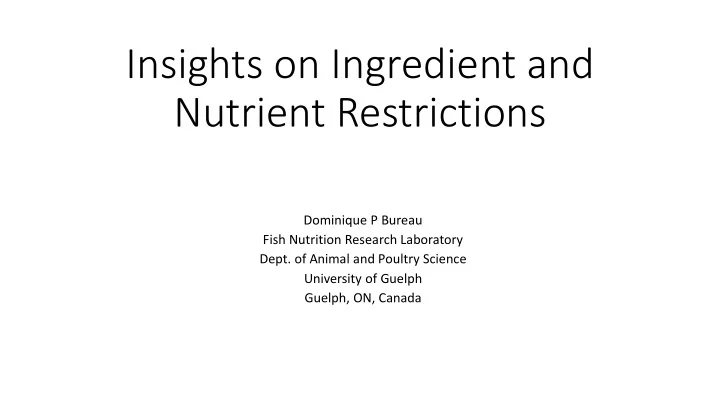

Insights on Ingredient and Nutrient Restrictions Dominique P Bureau Fish Nutrition Research Laboratory Dept. of Animal and Poultry Science University of Guelph Guelph, ON, Canada
Nutritional Specifications • Nutritional specifications are guidelines. The are defined carefully, reviewed occasionally, and generally quite strictly followed by feed formulators to ensure consistency of nutritional quality of feeds • Nutrient restrictions are “practical” values taking into account : • Requirements of the animal • Production objectives • Ex: Minimizing cost of formula while obtaining maximum performance • Uncertainties • Ex: Uncertainties around estimate of nutritional composition, nutritional requirements or potential losses of nutrients requiring use of certain safety margin • Requires/ hinges on reliable characterization of composition of ingredients • Interdependence of nutritional specifications is not always well handled by least-cost feed formulation program • Important role of nutritionist and feed formulator to review and make rational adjustments
Least Cost Feed Formulation = Linear Programming Program solving a series of linear (additive) equations to achieve a certain objective (i.e. minimize cost) Solving dozens of independent equations until all equations are “true” No real linkage / feedback loop between equations Some nutritional specifications are interrelated but the program doesn’t know this. Digestible Lysine content >= 2.4% Digestible Methionine content >= 0.7% Digestible TSAA content > = 1.1% Α -Linolenic Acid Content > = 1.0% Total n-3 fatty acid content > = 1.0% EPA content >= 0.2% DHA content >= 0.4% EPA+DHA Content >= 0.6% Total Phosphorus content Digestible Phosphorus content
In Ingredient Restrictions • G enerally driven by practical considerations and “gaps” in knowledge • Considerations: • Effect on processing (handling limitations, effect on pellet quality, etc.) • Chemical and/or nutritional characteristics not easily or not adequately addressed through the current nutritional specifications • Logistical, risk management and market issues (limited availability, contamination, variability, final product characteristics, customer concerns, export regulations, etc.) • In general, the more we characterize the animals and the ingredients, the less important the ingredient specifications. However, some logistical considerations still always play a role
Recommend
More recommend